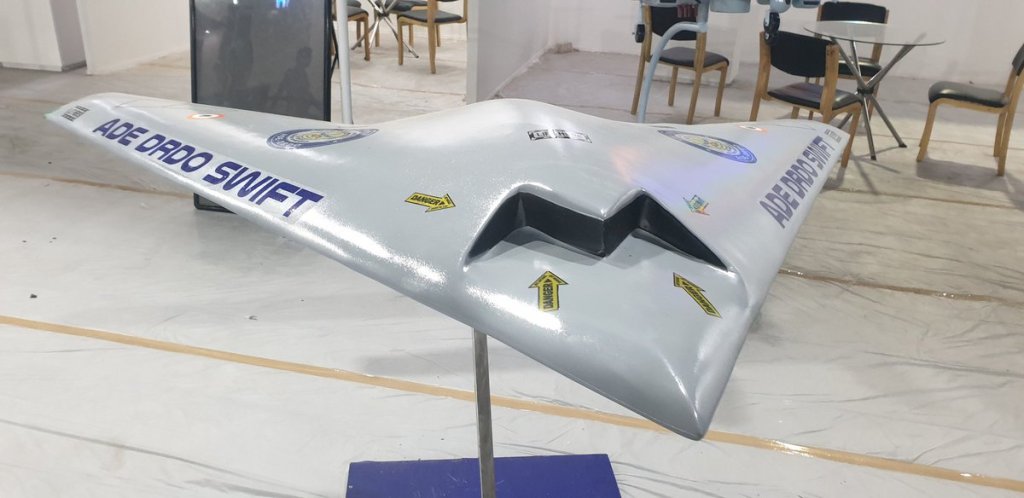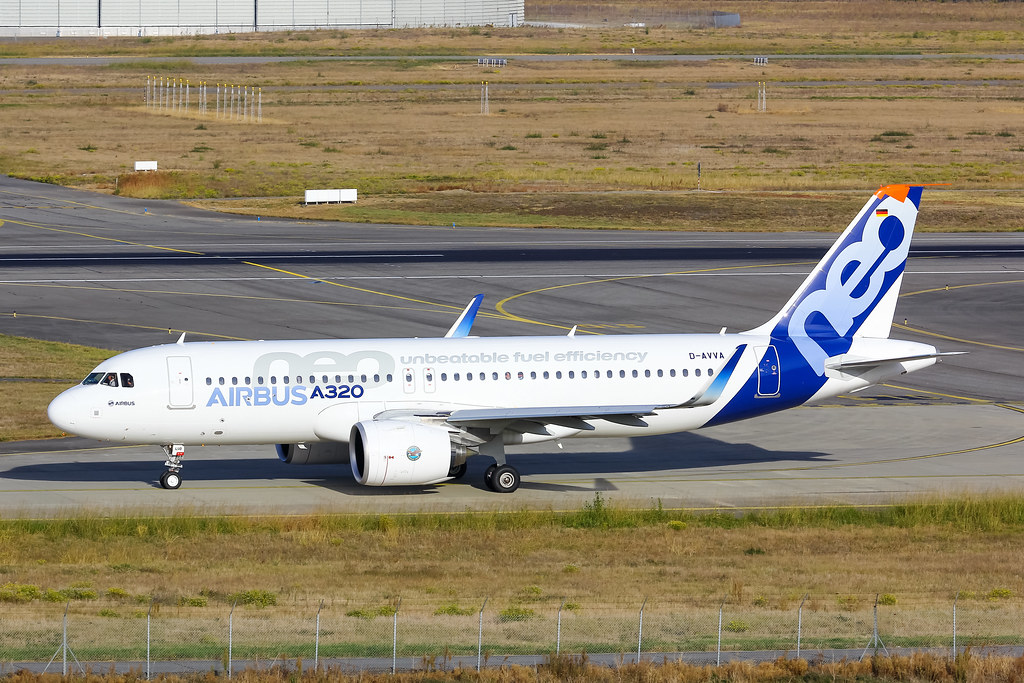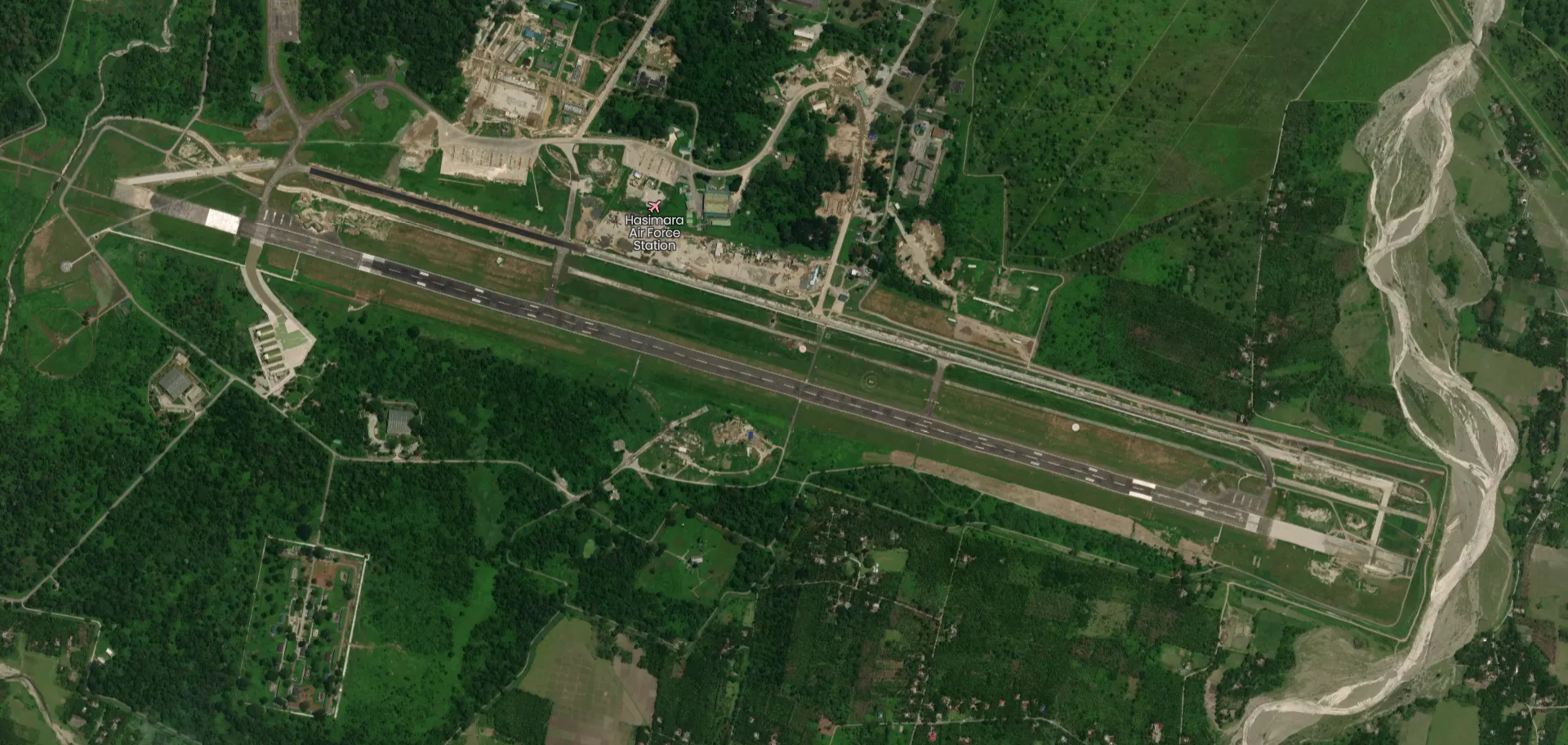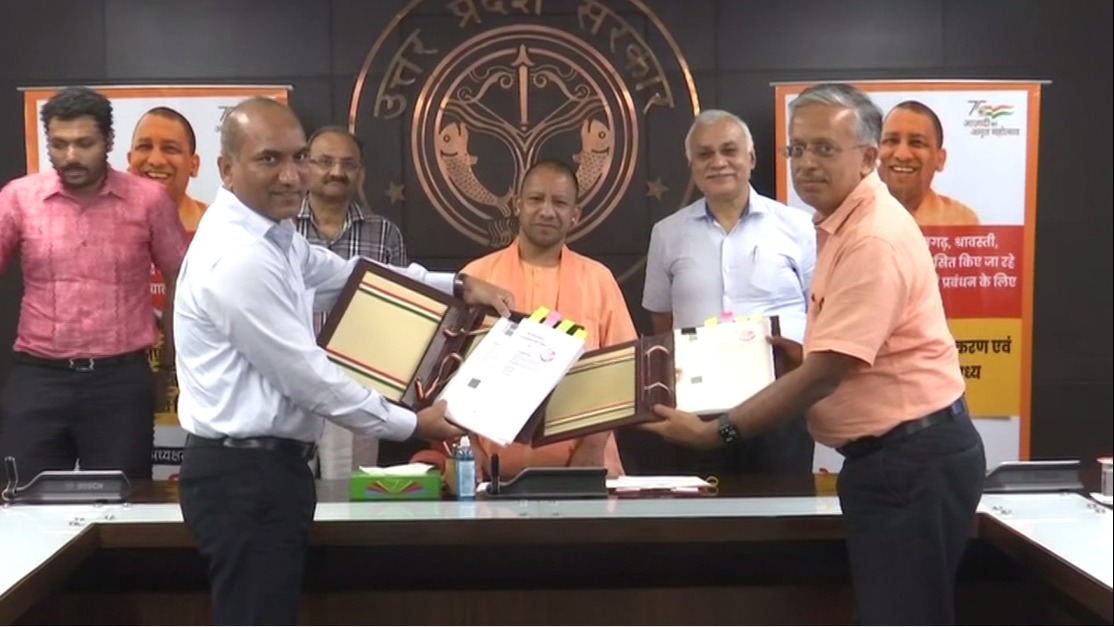Airbus SE won one of its biggest-ever orders for 292 airliners worth more than USD 37 billion from four Chinese airlines, a coup for the European manufacturer as it tussles with Boeing Co. for dominance in Asia’s largest economy.
China Eastern Airlines Corp. will buy 100 A320neo narrow-body jets, while Air China Ltd. will take 64 units, with its Shenzhen Airlines subsidiary acquiring 32 more, according to separate company filings. China Southern Airlines Co. said earlier it would buy 96 A320neos, as well as lease additional planes.
The announcements represent China’s first major jetliner orders in about three years and help cement Airbus’s position in the market, where the European manufacturer has built an advantage thanks to a local final assembly line.
Chinese airlines orders 292 Airbus A320neo aircraft (Image Courtesy - AeroTime Hub)
Boeing has historically counted China Southern as its biggest customer, but business has slowed for the manufacturer in the wake of two crashes of its best-selling 737 Max model and as political tensions rise between Washington and Beijing.
Boeing reacted sharply to the announcement, unusually crediting "constructive dialogue" between European governments and Beijing for the blockbuster order and urging the U.S. and Chinese governments to engage in productive discussions.
The orders were announced to add to robust demand from China. Airbus secured a USD 35 billion jet deal during a state visit by President Xi Jinping to the French capital in March 2019. Both manufacturers will be vying for more business at the Farnborough Air Show, which kicks off in the middle of the month at a venue south of London.
Boeing has counted China Southern as its biggest customer, but business has slowed for the manufacturer in the wake of two crashes of its best-selling 737 Max
Airbus gained as much as 4.9% in Paris. Boeing rose as much as 3.7% in US trading.
The China Southern aircraft will be delivered from 2024 to 2027, according to a stock exchange filing Friday, July 1. The carrier will separately lease 19 A320neos. Handovers to Air China will span from 2023 to 2027 and those to Shenzhen Airlines from 2024 to 2026.
China Southern in May removed more than 100 of the US firm’s 737 Max jets from its near-term fleet plans, citing uncertainty over deliveries. The airline previously outlined plans to rapidly expand its 737 Max fleet, saying in March that 39 were due this year, building toward a total of 103 deliveries through 2024.
Airbus secured a USD 35 billion jet deal during a state visit by President Xi Jinping to the French capital in March 2019.
None of China’s other state-owned carriers has said if they might resume taking the Max once it’s officially back in service. China was the first to ground the plane following fatal crashes in Indonesia in October 2018 and Ethiopia in March the following year.
Still, Boeing managed to outsell Airbus in 2021 for the first time in three years on demand for the 737 Max. The planemaker notched 909 gross orders in 2021, compared with 771 sales at Toulouse, France-based Airbus.
Since the Max grounding, Airbus has surged ahead of Boeing in grabbing orders and market share for narrowbody jets, even as the European planemaker struggles with ramping up production to meet surging demand. Last month, Chief Executive Officer Guillaume Faury said a delayed arrival of engines meant Airbus was unable to deliver otherwise fully built jets.
At the end of 2021, China Southern -- the country’s largest airline -- had a fleet of 399 Boeing narrowbodies
To meet its growing backlog, Airbus is pushing ahead with ambitious plans to ramp up production of its bestselling A320 family of jets to 75 a month by 2025 as it looks to widen its lead. Airbus wants to begin making the larger A321neo at its site in Tianjin by year-end.
Fast-growing Indian budget carrier IndiGo, operated by InterGlobe Aviation Ltd., is the world’s largest customer for A320neos, having ordered 730 of those jets.
At the end of 2021, China Southern -- the country’s largest airline -- had a fleet of 399 Boeing narrowbodies, according to its latest annual report. It also had 334 Airbus A320 series narrowbodies at the end of 2021.
China Eastern has been roiled by the crash of a Boeing 737-800 jet in March, killing 132 people on board.
ALSO READ - China Eastern B737-800 crash – here’s what is known so far
China Eastern has been roiled by the crash of a Boeing 737-800 jet in March, killing 132 people on board. Investigators are examining the actions of the crew, with no evidence found of a technical malfunction, people briefed on the matter have said.
ALSO READ - Airbus plans to increase production of its single-aisle narrowbody A320-family jets in 2023
ALSO READ - The Airbus-Boeing duopoly – can it ever be broken?
(With Inputs from Bloomberg)
Cover Image - Nathan Walkowiak (Flickr)
Read next
In a first, India conducts the maiden flight of its "Stealth Wing Flying Testbed"
Prashant-prabhakar
02 Jul 2022

In what can be termed a major advancement toward India's plans to have a full-fledged stealth combat drone, the country successfully carried out the maiden flight of the Autonomous Flying Wing Technology Demonstrator from the Aeronautical Test Range at Chitradurga in Karnataka on Friday.
Defence View
The test demonstrator dubbed the "‘Stealth Wing Flying Testbed’ (SWiFT)", has an uncanny resemblance and looks like the mini version of a US B-2 stealth bomber with a similar “flying wing” configuration.
According to DRDO, the aircraft performed a perfect flight, including take-off, way-point navigation and a smooth touchdown while operating in a fully autonomous mode.
This flight marks a major milestone in terms of proving critical technologies towards the development of future unmanned aircraft and is a significant step towards self-reliance in such strategic defence technologiesDRDO
SWiFT-India’s secretive unmanned combat aerial vehicle (UCAV) programme
SWiFT UAV is a Technology Demonstrator and is a scaled-down version of Ghatak UCAV (Unmanned Combat Air Vehicle). The main intent of SWiFT UAV is to demonstrate and prove the stealth technology and high-speed landing technology in autonomous modeDRDO
Wikipedia
Ghatak is intended to be an unmanned aircraft which can not only be used for surveillance but also to fire precision weapons at designated targets, using its stealth features to avoid detection by enemy sensors in contested airspace.
In June 2021, DRDO initiated ground trials of the first assembled prototype weighing 1-ton all-up weight and powered by an NPO Saturn 36MT turbofan engine. The Russian engine will be replaced by Manik Small Turbofan Engine (STFE) at a later stage developed Gas Turbine Research Establishment (GTRE) which was already successfully tested on the Nirbhay cruise missile and Indigenous Technology Cruise Missile (ITCM).
NPO Saturn 36MT turbofan | Twitter
Reportedly, the airframe, undercarriage and the entire flight control and avionics systems were all developed indigenously.
https://www.youtube.com/watch?v=P_OC4H8OzL4
The Defence Ministry highlighted that the aircraft marks a major milestone in terms of proving critical technologies for the development of future unmanned aircraft. Furthermore, this aircraft is a significant step toward self-reliance in such strategic defence technologies.
A full-scale prototype is expected in 2024–25.
SOURCE(s)
COVER: Defence View
Read next
The Airports Authority of India has written to the Bengal government for 37.74 acres of land next to the Indian Air Force base in Hasimara to convert it into a civil enclave to operate passenger flights.
Hasimara is located right in the Dooars, close to the Bhutan border as well as the Jaldapara wildlife sanctuary.
Sources in the AAI said the outfit’s jurisdiction would be limited to the passenger terminal while all other activities at the civil enclave would be handled by the IAF.
AAI plans to upgrade Hasimara Air Force Station into a civilian airport. (Image Courtesy - Foursquare)
Civil aviation minister Jyotiraditya Scindia, in a letter to Alipurduar MP John Barla, revealed that AAI had surveyed the infrastructure at Hasimara and found it suitable to operate C-type civilian aircraft or commonly-used planes such as Airbus A320 and Boeing B737.
This also makes the airport suitable for the operation of smaller aircraft such as ATR, Bombardier Q400 Dash 8 and Embraer ERJ that are used in regional flights.
The airport at Hasimara, which has a 2,740-metre runway, is used for sorties by IAF’s Sukhoi Su-30MKI and Rafale fighter jets. Bagdogra, the only other airport in north Bengal, is 137km from Hasimara.
Bagdogra, the only other airport in north Bengal, is 137km from Hasimara (Image Courtesy - Construction World)
If Hasimara gets the go-ahead, it will be an alternative to Bagdogra, which is also a civil enclave. This April, when Bagdogra had been shut for runway repairs, fliers did not have a viable alternative though some did fly to Pakyong Airport in Sikkim and then undertook a five-hour road journey to reach Siliguri.
“I assure you of all cooperation of this ministry,” Scindia added.
The three airports nearest to Hasimara are Bagdogra, Cooch Behar and Rupsi, which is in the Dhubri district of Assam. These are located 137km, 57km and 117km, respectively, from Hasimara. The Cooch Behar airport, however, is not operational.
Rafale fighter jets inducted into the 101 squadrons of the IAF that are posted at the air force base are stationed there. (Image Courtesy - Telegraph India)
Hasimara Air Force Station is an Indian Air Force (IAF) base located in Alipurduar district, West Bengal. It was established in 1962 during the India-China war. Rafale fighter jets inducted into the 101 squadrons of the IAF that are posted at the air force base are stationed there.
Hasimara is located strategically near the Indo-Bhutan border. It is also the closest Indian air base to the Chumbi Valley - the tri-junction between the Indian state of Sikkim, Bhutan and the Tibet Autonomous Region.
The airport is situated at an elevation of 340 ft (104 m) above mean sea level. It has one runway with concrete surfaces: 11R/29L measuring 9,000 by 148 feet (2,743 by 45 m).
Cover Image - Trishul Trident
Read next
The Airports Authority of India (AAI) signed an agreement with the Uttar Pradesh government on Friday, July 1 to operate and manage airports in Aligarh, Azamgarh, Chitrakoot, Muirpur and Shravasti for a period of 30 years, an official statement said.
According to the agreement, the state government will complete the construction, ready the airports for commercial operations, and then hand them over to the AAI for operation and management, the AAI’s statement noted.
The Uttar Pradesh government will provide dedicated infrastructure for utilities like water, electricity and drainage connections at the airports, it mentioned.
https://twitter.com/AAI_Official/status/1542879562258092032
The AAI will operate and manage the airports and provide all necessary services, the statement read citing the agreement.
“The agreement was signed by N V Subbarayudu, Executive Director (Strategic Initiative Unit) on behalf of AAI and Kumar Harsh, Special Secretary, Civil Aviation Department, Government of Uttar Pradesh on behalf of the state government in presence of Chief Minister Yogi Adityanath” it mentioned.
The Airports Authority of India or AAI is a statutory body, under the ownership of, the Ministry of Civil Aviation, Government of India. It is responsible for creating, upgrading, maintaining and managing civil aviation infrastructure in India.
AAI signs agreement with UP government to operate and manage 5 airports (Image Courtesy - AAI)
It provides Communication Navigation Surveillance / Air Traffic Management (CNS/ATM) services over Indian airspace and adjoining oceanic areas.
AAI is currently managing a total of 137 Airports, including 34 International Airports, 10 Customs Airports, 81 Domestic Airports and 23 Civil enclaves at Defense Airfields. AAI also has ground installations at all airports and 25 other locations to ensure the safety of aircraft operations.
AAI covers all major air routes over Indian landmass via 29 Radar installations at 11 locations along with 700 VOR/DVOR installations co-located with Distance Measuring Equipment (DME). 52 runways are provided with Instrument landing system (ILS) installations with Night Landing Facilities at most of these airports and an Automatic Message Switching System at 15 Airports.
Cover Image - AAI
Read next
SpiceJet flight makes emergency landing after smoke detected inside cabin
Radhika Bansal
02 Jul 2022
A SpiceJet aircraft returned to Delhi on Saturday, July 2 morning after smoke was detected in the cabin.
The cabin crew first noticed the smoke on the Dash8 Q400 (VT-SUR) that was operating as SG-2962 from Delhi to Jabalpur. The aircraft was passing 5,000 feet during ascent when the incident happened.
“Cabin crew informed the pilots about the mild smoke in the cabin. On the visual check, no sign of smoke or damage was observed in the lavatory. The smoke warning also went off,” said sources.
https://twitter.com/ANI/status/1543078626861940736
Then while further climbing 14,000 feet, smoke was seen to be increasing in the cabin. The pilots levelled the aircraft at 15,000 feet and decided to return to Delhi by informing the Air Traffic Control and declaring 'MAY DAY'.
The aircraft, which had taken off at 6:29 AM, landed safely in Delhi around 7:20 AM and passengers were evacuated on a taxiway in coordination with the ATC. The Directorate General of Civil Aviation (DGCA) is probing the incident.
The cabin crew first noticed the smoke on the Dash8 Q400 (VT-SUR) that was operating as SG-2962 from Delhi to Jabalpur.
A SpiceJet spokesperson said: “On July 2, 2022, SpiceJet Q400 aircraft was operating SG-2962 (Delhi-Jabalpur). While passing 5000 feet, the crew noticed smoke in the cabin. The pilots decided to return ba Delhi. Aircraft landed safely at Delhi and passengers were safely disembarked.”
On June 19, 2022, a SpiceJet Dash8 Q400 flying from Delhi to Jabalpur as SG 2962 returned to IGI Airport soon after take-off after the turboprop (VT-SUU) suffered a “pressurisation snag”. The DGCA had recently conducted checks on the entire fleet of the budget airline.
ALSO READ - 2 SpiceJet flights abort take-off following fuselage door warnings
On June 19, 2022, a SpiceJet Dash8 Q400 flying from Delhi to Jabalpur as SG 2962 returned to IGI Airport soon after take-off after the turboprop (VT-SUU) suffered a “pressurisation snag”.
An incident was reported on May 25, certain SpiceJet systems faced an attempted ransomware attack that impacted and slowed down flight departures.
ALSO READ - SpiceJet under attack by ransomware; morning flights affected
On May 4, SpiceJet flight SG-331 operating from Chennai to Durgapur on May 3 returned to Chennai after take-off due to a technical issue. At that time also the aircraft landed back safely.
ALSO READ - Spicejet mid-air turbulence – here’s what is known so far
Read next
More than 1,600 employees of Air India, the former state-run carrier now owned by the Tata group, have opted for voluntary retirement under a scheme announced on June 1.
These employees comprise 22% of permanent staff (around 7,000). The airline has a total employee strength of around 10,800, including those on contract.
At first, employees older than 55 and with 20 years of continuous employment could opt for a voluntary retirement scheme (VRS). The rules were relaxed in June and VRS opened for those older than 40 among cabin crew, clerical and unskilled categories. Pilots were not included in this scheme.
Over 1,600 Air India employees opt for voluntary retirement scheme
Those who have opted for VRS until June end will get an additional incentive of INR 1 lakh and the scheme will continue till July end. A senior executive of Air India said the Tata group would appoint professional agencies to reskill the staff who opt for VRS.
Cabin crew, peons, clerical assistants, housekeeping staff and security guards are among employees opting for VRS. Around 2,800 employees are eligible to take VRS and those opting for it account for around 57%.
Air India has over 10,000 employees, of which around 7,000 are permanent. Thousands are said to be retiring over the next five years.
Around 2,800 employees are eligible to take VRS and those opting for it account for around 57%.
ALSO READ - Air India offers to rehire pilots post-retirement for 5 years
According to the disinvestment conditions, the Tata Group cannot lay off employees for one year from taking ownership and can offer VRS in the second year. Some unions have also been examining whether the current move violates the term of the sale or not.
“Most of those who are opting for VRS have around two to three years of their service period left. Functions of multiple departments like security driver or loader where Air India under the government had hired permanent staff are going to be outsourced. So, it is a good proposition for them,” said an airline executive.
The Tata group acquired Air India in January. By investing in aircraft and technology, the group hopes to make the airline efficient and profitable.
Air India is hiring cabin crew between 18-32 years as it prepares for its expansion.
“If you have to get an edge over others you have to break away from the past,” said a former senior executive. The VRS scheme would make the airline leaner and cut establishment costs, he said.
Air India is hiring cabin crew between 18-32 years as it prepares for its expansion. It did not respond to an emailed query about the VRS scheme.
Not everyone is happy. “The VRS scheme is a tactic to break the resistance of employees who are opposing eviction from staff quarters. We were assured that there would be job protection for one year after disinvestment,” said George Abraham, a member of the Aviation Industry Employees Guild.
Air India has over 10,000 employees, of which around 7,000 are permanent.
There is a lot more discipline and accountability in the airline's internal functioning now but somewhere unhappiness too has crept in, employees said. This is especially among crewmembers who fear losing jobs to new recruits.
“There is a lot of stress. The rest period between flights is at a minimum. There is also apprehension that airline management will tighten body mass index norms. Some are worried about a possible transfer to Delhi,” said a senior crewmember.
(With Inputs from Business Standard)





Comment